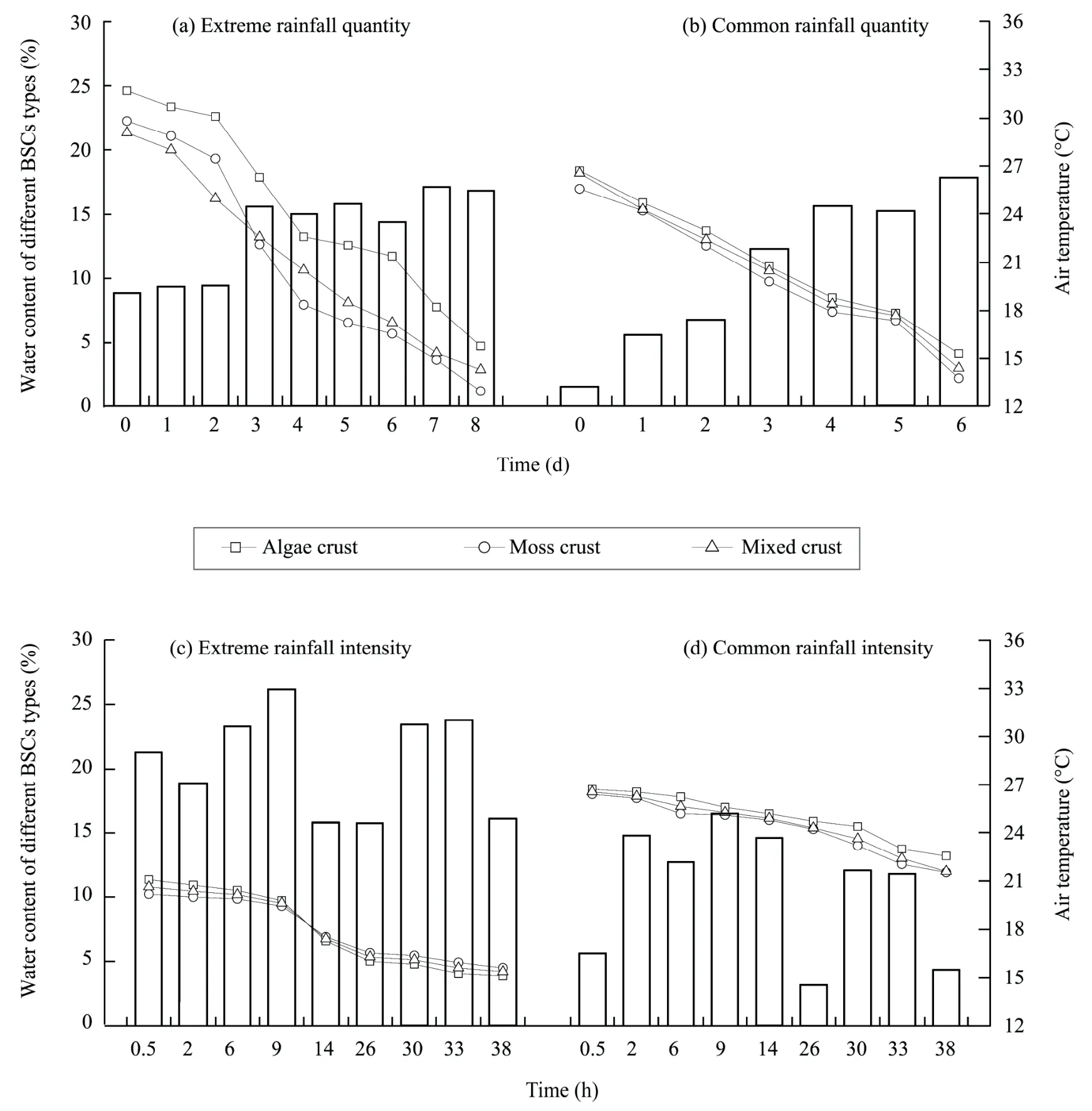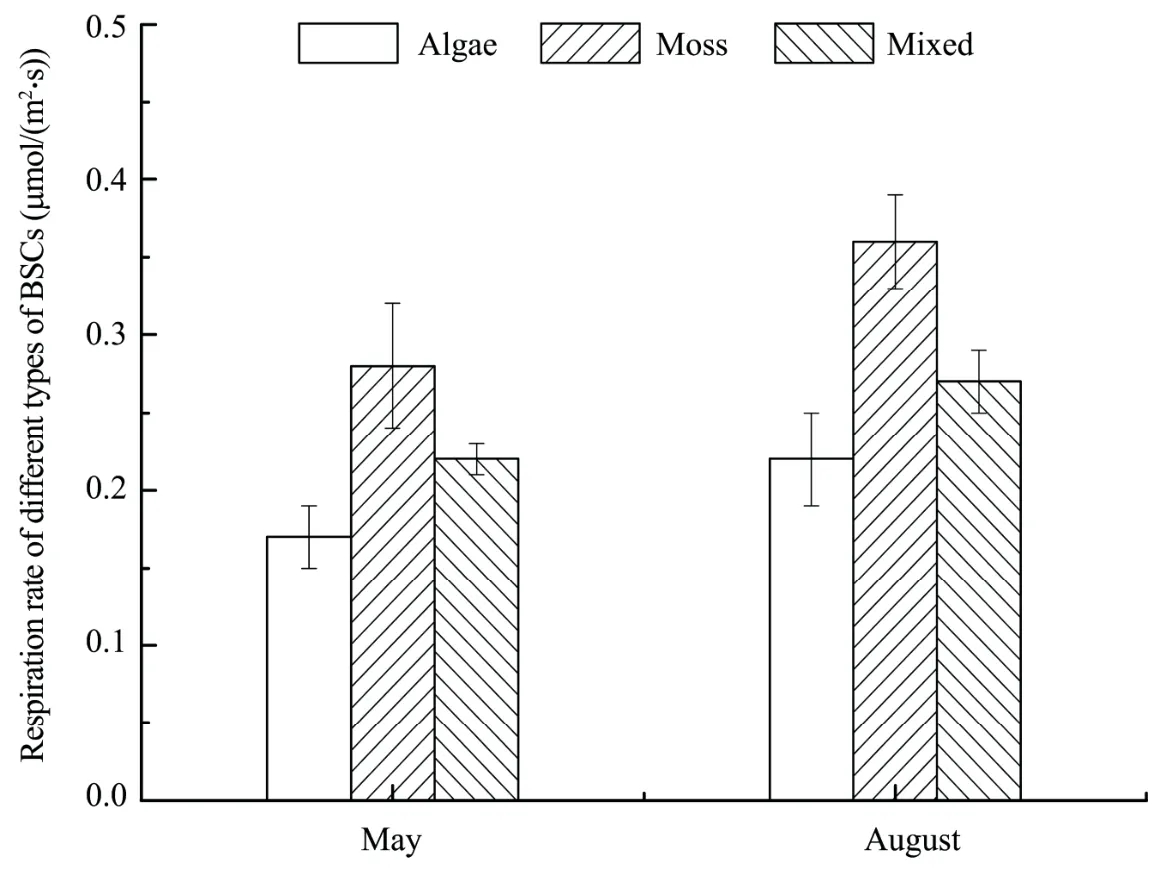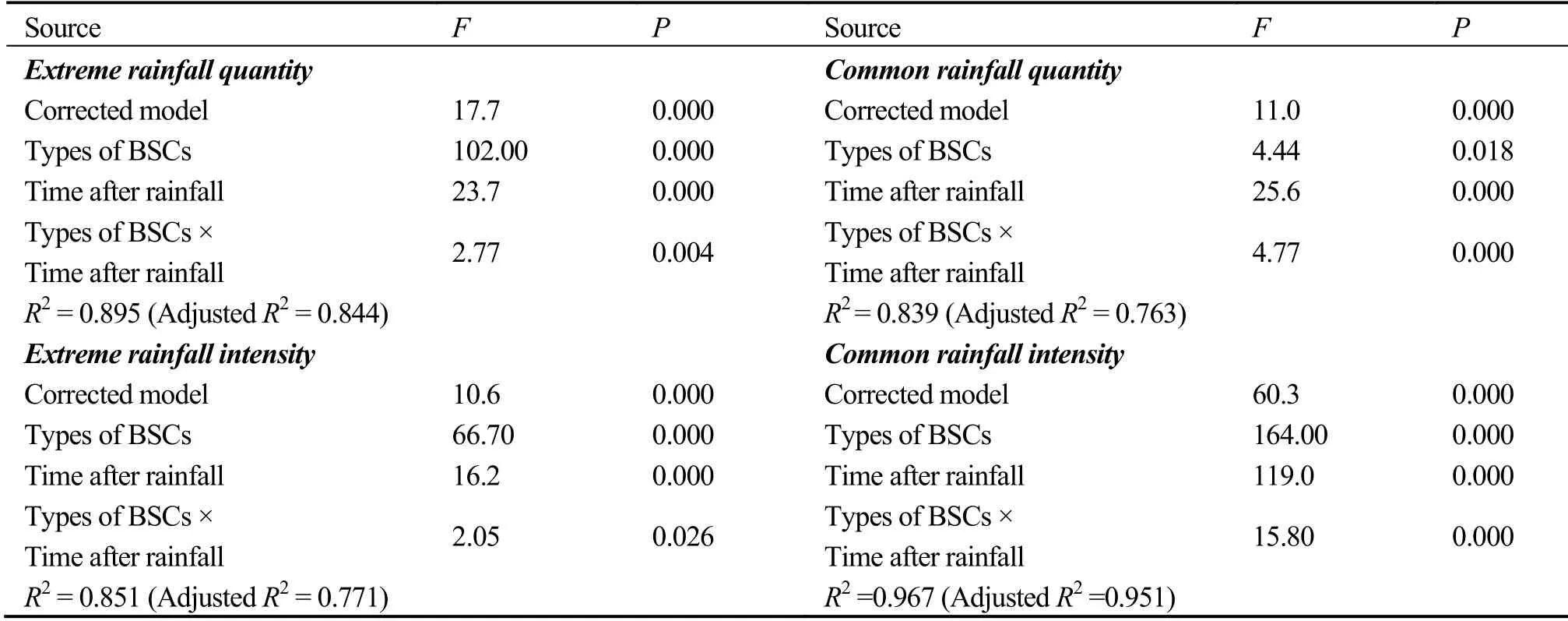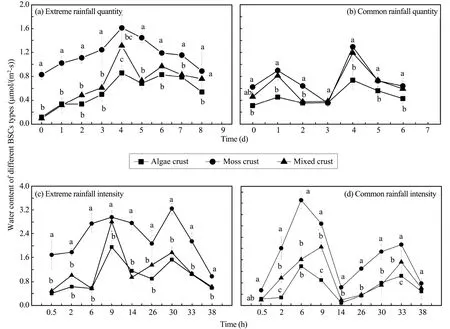The effects of extreme rainfall events on carbon release from biological soil crusts covered soil in fixed sand dunes in the Tengger Desert,northern China
Yang Zhao,XinRong Li ,ZhiShan Zhang,RongLiang Jia,YiGang Hu,Peng Zhang
Shapotou Desert Research and Experiment Station,Cold and Arid Regions Environmental and Engineering Research Institute,Chinese Academy of Sciences,Lanzhou,Gansu 730000,China
1 Introduction
Biological soil crusts (BSCs) living within or immediately on top of the uppermost millimeters of soil,result from an intimate association between soil particles and cyanobacteria,algae,micro fungi,lichen,and moss in varying proportions.They are a common and widespread feature of arid and semi-arid landscapes throughout the world,and produce a living cover of up to about 40% in arid and semi-arid zones (West,1990;Eldridge and Greene,1994;Belnap and Lange,2003).The presence of BSCs is evidence of improved soil conditions because BSCs can stabilize soil by their filaments or rhizoids entwining soil particles.They can also retain water at about 13 times their own weight,which can significantly change the surface soil moisture conditions.In addition,BSCs can fix nitrogen and carbon from the air to increase the nutrition content in soil.All of these mechanisms can significantly alter soil properties in arid and semi-arid regions (Belnap and Lange,2003).
The effects of climate change on terrestrial ecosystems is of wide scientific and public concern.Global climate change can potentially affect ecological service functions within ecosystems,as described by Parsonet al.(2003),Bennettet al.(2005),and Fayet al.(2008).The increasing incidence of extreme rainfall events,as defined by the World Meteorological Organization (WMO),is one of the obvious characteristics of climate change (Christensen and Hewitson,2007).Globally,extreme rainfall events show increasing trends at regional and small scales;for example,in the 20th century,global land rainfall increased only 9 mm (except in Antarctica),but at the district scale,in parts of North America,Europe,and South Africa the number of days of rain increased.In Europe,Africa,Australia,and the Mediterranean region,droughts have increased in frequency,but in some areas great rainfall events have also increased (Newet al.,2001).It is expected that in the 21st century extreme rainfall events will continue to increase in frequency (Groismanet al.,2005;Alleyet al.,2007).
BSCs are an important contributor of carbon emissions in arid and semi-arid regions (Castillo-Monroyet al.,2011),and rainfall is an important factor influencing soil carbon release in such areas (Huxmanet al.,2004;Sponseller,2007).However,studies of natural rainfall events usually focus on average events;there have been few studies on extreme rainfall events and there has been only one research study on extreme rainfall which used rainfall simulations(Fayet al.,2008).Past studies on the BSC carbon cycle were focused on carbon exchange,yearly CO2release quantity (Thomaset al.,2008;Thomas and Hoon,2010),and the simulated effect of rainfall on carbon release (Wilskeet al.,2009).However,there is sparse information on the effects of extreme rainfall on soil conditions as related to BSC release of carbon (Castillo-Monroyet al.,2011).Therefore,this study investigates the carbon released by BSC-covered soils under extreme natural rainfall conditions (quantity and intensity).Our results provide reliable data support to enhance understanding of the carbon released by and the response characteristics of BSC-covered soil.We also analyzed the relationship between carbon release,soil moisture content,and the type of BSC.
2 Experimental design
The Shapotou region is located at the southeastern edge of the Tengger Desert in north-central China (37°33′N,105°02′E) with an elevation of 1,339 m a.s.l.The area is a typical transitional zone between desert and oasis,where natural vegetation is dominated byHedysarum scopariumandAgriophyllum squarrosum,with a cover of approximately 1%.The area is characterized by high,dense,and continuous reticulate barchan dunes.The soil substrate is loose and impoverished moving sand,with a moisture content varying between 2% and 4%.The mean annual air temperature in the area is 9.6 °C,with extreme minimum and maximum temperatures of-25.1 and 38.1 °C,respectively (Liet al.,2003).
In October of 2010 we took three types of BSC samples(algae,moss,and mixed crusts composed of algae,moss,and lichen) from undisturbed soil by using 10.4-cm-diameter,20-cm-tall PVC tubes.We took these samples in selected flat,open spaces in the 1964 re-vegetation area at the southeastern edge of the Tengger Desert to avoid the influence of crust development by the terrain environment and vegetation.The samples were taken to the nearby experimental station and buried in soil (still in the PVC tubes),keeping the BSC surfaces at the same level as the soil surface.In order to make the test conditions closely resemble the natural environment,we maintained the natural soil water and air cycles and we kept the bottoms of the PVC tubes open for drainage.
3 Definition of extreme rainfall events
In this study we used WMO standards to define the extreme weather events.The WMO definition is that a climate extreme (extreme weather or climate event) is the occurrence of a value of a weather or climate variable above (or below) a threshold value (occurred more than 25 years,or their corresponding years average (generally 30 years)) near the upper (or lower) ends of the range of observed values of the variable.Rainfall is a primary characterization of climate(one of the most basic attribute elements),so rainfall that conforms to the above definitions is here considered an "extreme rainfall event" (Christensen and Hewitson,2007).Therefore,an extreme rainfall event is one with a quantity of more than 30 mm or an intensity of more than 0.15 mm/min in our study region.As Table 1 shows,rainfall events 1 and 2 can be defined as extreme rainfall events,whereas rainfall event 3 is considered a common rainfall event.

Table 1 Characteristics of rainfall events in the study period
Fieldwork was conducted from May to August in 2011,using a Li-6400-09 Soil Chamber (LI-COR Environmental,Inc.,Lincoln,Nebraska,U.S.A.) to measure the respiration rates of BSC-covered soils.Measurements were taken immediately after rainfall event 1 and continued at 9:00 every day until the respiration rate returned to the basal level before the rain.After rainfall event 2,measurements were taken at 0.5,2,6,9,14,26,30,34,and 38 h after the rain;the same was done after rainfall event 3 as control measurements.Before the measurements,samples of the three BSC types were removed and the remaining surfaces were kept clean of debris.
4 Variation of post-rain air temperature and BSC water content
During the experimental period,the air temperatures were 9-33 °C and 2-27 °C after the extreme and common rainfall events,respectively.In the three types of BSC samples(algae,mixed,and moss),the water contents were 0.5%-25% and 0.5%-18% after the extreme and common rainfall events,respectively.The algae and mixed crusts had higher water contents than did the moss crust in both the extreme and the common rainfall events,because the moss crust had a greater biomass than did the other crust types,which led to a higher water loss rate.Later in the study period there were no differences in water contents among the three types (Figure 1).

Figure 1 Variation of air temperature and BSC sample water contents in the experimental period.The lines represent BSC water contents and the histogram bars represent air temperature
5 The effects of extreme and common rainfall events(rainfall quantity and rainfall intensity) on respiration rates of different types of BSCs
The algae,moss,and mixed crust respiration rates were 0.17-0.22,0.28-0.36,and 0.22-0.27 μmolCO2/(m2·s),respectively,before the rain events (Figure 2).After the extreme and common rainfall events,our results showed that the types of BSC and the length of time after the rain significantly influenced the soil carbon release (Table 2).
As shown in Figure 3,under the extreme rainfall quantity condition,the soil carbon release process of the moss crust exhibited a unimodal curve that gradually increased and then declined.The lowest respiration rate occurred soon after the rain [0.83 μmolCO2/(m2·s)],and the highest respiration rate occurred in the fourth day after the rain [1.61 μmolCO2/(m2·s)].The algae and mixed crusts showed similar bimodal process curves,wherein the lowest respiration rates occurred soon after the rain [0.1-0.2 μmolCO2/(m2·s)];the highest respiration rates occurred on the fourth day after the rain [0.83 and 1.31 μmolCO2/(m2·s),respectively].The mixed crust released slightly more carbon than did the algae crust,but this was not significantly different.
Under the common rainfall quantity condition,the soil carbon release processes for all three types of BSCs exhibited bimodal curves,with the highest respiration rates occurring on the fourth day after the rain;the algae,moss,and mixed crust rates were 1.29,0.74,and 1.19 μmolCO2/(m2·s),respectively.The moss crust released significantly more carbon than did the algae and the mixed crusts throughout the whole period after the rain;the mixed crust released more carbon than did the algae crust,but this was not significantly different.
Under the extreme intensity rainfall condition,the soil carbon release process of the moss crust exhibited a bimodal curve;the highest respiration rate occurred 30 h after the rain and was 3.25 μmolCO2/(m2·s).The algae and mixed crusts showed similar trimodal processes in which the lowest respiration rate occurred soon after the rain [0.2-0.3 μmolCO2/(m2·s)],and the highest respiration rates occurred in the ninth hour after the rain [1.53 μmolCO2/(m2·s) for algae and 1.77 μmolCO2/(m2·s) for mixed].Under the common rainfall quantity condition,the moss and algae crust soil carbon release processes exhibited bimodal curves,in which the highest respiration rates occurred in the seventh hour after the rain [3.71 and 1.38 μmolCO2/(m2·s),respectively],and the highest respiration rate of the mixed crust occurred in the tenth hour after the rain [1.62 μmolCO2/(m2·s)].The moss crust released more carbon than did the algae and mixed crusts throughout the whole period after the rain;the mixed crust released more carbon than did the algae crust,but this was not significantly different (Figure 3).

Figure 2 Pre-rainfall respiration rates of the three types of BSCs in May and August of 2011

Table 2 Two-way ANOVA analysis on effects of BSC type and length of time after a rainfall on carbon release from BSC-covered soil

Figure 3 The effects of extreme and common rainfall events (rainfall quantity and rainfall intensity) on the respiration rates (mean ± SE) of the different BSC types.The different small letters represent the significance at P<0.05
Regression analysis of the relationships between the respiration rates and moisture contents of soils covered by different types of BSCs demonstrated statistical significance in both the extreme and common rainfall conditions,the values ofR2are in a range of 0.490-0.997 and all thePvalues are less than 0.05 (Table 3).

Table 3 Relationships between the soil respiration rates and moisture contents of soils covered by different types of BSCs
6 Discussion
Soil water content has been proven to be the most important factor influencing soil carbon release:either too much or too little soil water can inhibit soil respiration,and the maximum soil respiration rate occurs in moderate soil water content (Huxmanet al.,2004;Sponseller,2007).This study demonstrates that extreme rainfall quantity and intensity can significantly inhibit respiration in algae and mixed crust covered soils,but have less influence on respiration in moss crust covered soil.In analyzing more than 50 years of continuous monitoring data from the southeastern edge of the Tengger Desert,Liet al.(2003) found that the sequence of BSC colony succession was:physical crust-algae crust-mixed crust-moss crust.Among the various BSCs,moss crust has higher infiltration rate than do algae crust,which is explained by algae crust having low biotic biomass and low roughness,and also low porosity due to the predominance of vesicle pores.Moss crust is highly permeable and has high water-holding capacity and micro-roughness,which slows runoff flux,thus delaying the onset of runoff by absorbing large amounts of water after a rain.Therefore,moss crust exhibits the highest total and steady-state infiltration rates(Liet al.,2010).
Kursar (1989) determined that as water in soil displaces CO2and the permeability of soil becomes poor,the diffusion resistance of CO2in the soil increases,causing soil CO2emissions.After an extreme rainfall event,a large quantity of water gathers in the soil surface,leading to poor soil permeability and increased CO2emissions.Also,moss crust have higher evaporation rate than do algae crust,and their evaporation rates are higher soon after a rainfall event than in later stages (Zhanget al.,2008).After an extreme rainfall,surface soil has high water content;then,due to early and significant water evaporation,the surface soil water content falls rapidly and at the same time reduces the inhibition on respiration,enabling the respiration rate to increase gradually.The evaporation capacity of moss crust is significantly higher than that of algae crust and the moisture content of moss crust decreases more rapidly than in algae and mixed crusts.And reduced the suppression of soil water on respiration rate,which can well explain why respiration in moss crust covered soil is little affected by extreme rainfall events.
To sum up,extreme rainfall conditions (quantity and intensity) can significantly inhibit the respiration rates of soil covered by algae and mixed crusts in the short term,but do not significantly affect moss crust covered soil in this way.This suggests that in later succession stages,moss crust can well adapt to extreme rainfall events in the short term.This study only addressed the short-term impacts of extreme rainfall on the soil carbon release processes in BSC-covered soil.The long-term effects will be the focus of future research.
The authors are very thankful to two reviewers for proposing good suggestions.This project is supported by the Innovation Project of the Chinese Academy of Sciences(Grant No.KZCX2-EW-301-3) and the National Natural Science Foundation of China (Grant Nos.41271061,41101081 and 40971033).
Alley RB,Berntsen T,Bindoff NL,2007.Climate change:the physical science basis,summary for policy makers.IPCC Secretariat,Geneva,Switzerland.
Belnap J,Lange OL,2003.Biological soil crusts:Structure,function,and management.Springer-Verlag,Berlin,Germany.
Bennett EM,Peterson GD,Levitt EA,2005.Looking to the future of ecosystem services.Ecosystems,8:125-132.
Castillo-Monroy AP,Maestre FT,Rey A,Soliveres S,García-Palacios P,2011.Biological soil crust micro-sites are the main contributor to soil respiration in a semiarid ecosystem.Ecosystems,14:835-847.
Christensen JH,Hewitson B,2007.Regional climate projections.In:Solomon S,Qin D,Manning M (eds.).Climate Change:the Physical Science Basis.Contribution of Working Group I to the Fourth Assessment Report of the Intergovernmental Panel on Climate change.Cambridge University Press,Cambridge,UK and New York,NY,USA,pp.847-940.
Eldridge DJ,Greene RSB,1994.Micro-biotic soil crusts:A view of their roles in soil and ecological processes in the rangelands of Australia.Soil Research,32:389-415.
Fay PA,Kaufman DM,Nippert JB,Carlisle JD,Harper CW,2008.Changes in grassland ecosystem function due to extreme rainfall events:implications for responses to climate change.Global Change Biology,14:1600-1608.
Groisman PY,Knight RW,Easterling DR,Karl TR,Hegerl GC,Razuvaev VN,2005.Trends in intense precipitation in the climate record.Journal of Climate,18:1326-1350.
Huxman TE,Snyder KA,Tissue D,Leffler AJ,Ogle K,Pockman WT,Sandquist DR,Potts DL,Schwinning S,2004.Precipitation pulses and carbon fluxes in semiarid and arid ecosystems.Oecologia,141:254-268.
Kursar TA,1989.Elevation of soil respiration and soil CO2concentration in a low land moist forest in Panama.Plant and Soil,113:21-29.
Li XR,Tian F,Jia RL,Zhang ZS,Liu LC,2010.Do biological soil crusts determine vegetation changes in sandy deserts? Implications for managing artificial vegetation.Hydrological Processes,24:3621-3630.
Li XR,Zhou HY,Wang XP,Zhu YG,O’Conner PJ,2003.The effects of sand stabilization and re-vegetation on cryptogam species diversity and soil fertility in Tengger Desert,Northern China.Plant and Soil,251:237-245.
New M,Todd M,Hulme M,Jones P,2001.Precipitation measurements and trends in the twentieth century.International Journal of Climatology,21:1899-1922.
Parson EA,Corell RW,Barron EJ,Burkett V,Janetos A,Joyce L,Karl TR,MacCracken MC,Melillo J,Morgan MG,Schimel DS,Wilbanks T,2003.Understanding climatic impacts,vulnerabilities,and adaptation in the United States:building a capacity for assessment.Climatic Change,57:9-42.
Sponseller RA,2007.Precipitation pulses and soil CO2flux in a Sonoran Desert ecosystem.Global Change Biology,13:426-436.
Thomas A,Hoon SR,Linton P,2008.Carbon dioxide fluxes from cyanobacteria crusted soils in the Kalahari.Applied Soil Ecology,39:254-263.
Thomas AD,Hoon SR,2010.Carbon dioxide fluxes from biologically-crusted Kalahari Sands after simulated wetting.Journal of Arid Environments,74:131-139.
West NE,1990.Structure and function of micro-phytic soil crusts in wild-land ecosystems of arid to semi-arid regions.Advances in Ecological Research,20:179-223.
Wilske B,Burgheimer J,Maseyk K,Karnieli A,Zaady E,Andreae MO,Yakir D,Kesselmeier J,2009.Modeling the variability in annual carbon fluxes related to Biological Soil Crusts in a Mediterranean shrubland.Biogeosciences Discuss,6:7295-7324.
Zhang ZS,Liu LC,Li XR,Zhang JG,He MZ,Tan HJ,2008.Evaporation properties of a revegetated area of the Tengger Desert,North China.Journal of Arid Environments,72:964-973.
 Sciences in Cold and Arid Regions2013年2期
Sciences in Cold and Arid Regions2013年2期
- Sciences in Cold and Arid Regions的其它文章
- Review of snow grain size retrieval from remote sensing
- Simulation on the spatio-temporal distribution and emission flux of dust aerosol over East Asia in 2000-2009
- Changes in daily climate extremes in Xinjiang,northwestern China
- East Asian Winter Monsoon record from the environmental sensitive grain size component of QF Old Red Sand,Haitan Island,China
- OSL chronology and paleoclimatic implications of paleodunes in the middle and southwestern Qaidam Basin,Qinghai-Tibetan Plateau
- Effects of shrubs and precipitation on spatial-temporal variability of soil temperature in microhabitats induced by desert shrubs
